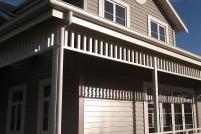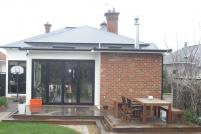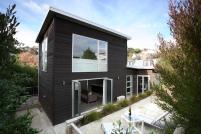-
 Featured: School Road Home
Dunedin
School Road farmhouse
Featured: School Road Home
Dunedin
School Road farmhouse
-
 Featured: St Clair Alterations
Dunedin
The client had bought this house because of the huge north
facing section. We were asked to enlarge the dining room
and build an outdoor living area.
Featured: St Clair Alterations
Dunedin
The client had bought this house because of the huge north
facing section. We were asked to enlarge the dining room
and build an outdoor living area.
-
 Featured: Janice Place
Christchurch
Another steep site, with sylvan views through a gully to the
ocean beyond.
Featured: Janice Place
Christchurch
Another steep site, with sylvan views through a gully to the
ocean beyond.
katipo design is a Dunedin-based Architectural Design Firm specialising in Residential Buildings on difficult sites with amazing views.
The Design and Contract Process
This page describes the process of working with an architectural designer and having your home subsequently built.
The orientation of the home and rooms on the land is a critical element in designing a successful home. Each block of land features different views, different privacy issues, and differing sunlight. Katipo Design put a huge amount of effort into aligning your dream home perfectly on your land to fully enrich your living.
The are five phases in the residential architecture process; concept design, developed design, working drawings, specification, and contract administration.
Below is an extensive list of the various factors involved in each phase. It's well worth reading this so you understand what makes up an Architectural fee, and why such a huge amount of paperwork is needed to build a good home.
CONCEPT DESIGN
Parties involved; Client, Designer, Territorial Authority (TA), Consultants.
Briefing
This is where the designer finds out what the client wants from their building.
- client's requirements and ideas, design objectives; size, shape, form, style, aesthetics, materials, finishes etc
- space requirements and space relationships - known as the functional program
- quality, budget, professional fees
- construction program - timeframe for completion
- property ownership and site requirements
- TA requirements, resource management act implications (TA = Territorial Authority, AKA The Council)
- building contracts, building strategies
- responsibilities of parties
- consultants and relationships
Site Analysis
The site is visited with the Client, to get the feel for it, and the relevant information.
- geographic factors; soil topography, vegetation etc
- climatic factors; sun, wind, rain, temperature
- sensory factors; views, sound, privacy
- regulatory factors; TA requirements, site boundaries
- existing and surrounding buildings (including neighbours); consider cultural and architectural traditions
- existing services; drainage, water, power, phone, gas, etc
- vehicle and pedestrian access, parking, measure existing buildings
After the brief and site analysis are complete, the designer has some idea of the limitations and opportunities, and may need to consult with others, including;
- client
- TA; building codes and regulations, town planners, resource management act
- engineers; geotechnical, structural, electrical, mechanical
- quantity surveyors; to get a feel for the price
- land surveyors
- landscapers; preservation of existing vegetation etc
Search Information From
- TA
- Land Information New Zealand; legal description
- library
- visiting similar buildings
- visiting manufacturers
Preliminary Sketch Design
Client, Designer, TA, and consultants are involved at this stage. Once the designer has the client's brief and site information, the design work begins.
At this stage the designer is not concerned with detail, but with an overall concept.
By the time the client is happy with the preliminary sketch design, most of the rooms and their placement will be decided, the building will be positioned on site, and some basic material selections will have been made.
Budget will be set at this stage.
Analysis of Information
- site plan showing TA, site, and physical constraints
- client brief
Problem Solving
- identify problems
- test alternative solutions
Produce Sketch Design
Exterior views perspectives
- materials and finishes
- elevations
Site plan
- size, shape, form, dimensions
- existing buildings, neighbours
- environment
Floor plans
- arrangement and size of rooms
- placement of furniture and fittings
- social interactions
Calculations
- floor area
- volume / height
- levels
- rough order of costs efficiencies
Present Design to Client
A maximum of two alternatives may be required at this stage
- alterations to sketch plan as required to achieve budget
- alterations to plans as required by client
Developed Design
This is the firming up of the design with the client, including major decisions such as materials, dimensions, etc. Also includes placement of doors and windows, wardrobes and other built-in furniture, electrical and plumbing fittings, landscaping and site-works.
Client's complete approval is sought at the end of this stage, as changes to the contract documents become more expensive and difficult to make.
- confirm all aspects of sketch design
- coordination and integration of consultants
- probable cost and program
- represent design to client
Make Resource Consent Applications
Client pays fees
Contract Documentation
Also known as "working drawings". The degree of documentation the client requires may vary, and ranges from minimal, which is just enough to obtain a building consent, through to full documentation suitable for tendering and construction purposes.
Modify Developed Design
Changes from now on may involve delay and additional fees to incorporate precise requirements from other consultants
Client pays consultants for additional design alteration fees
Prepare Contract Documents
Location drawings
- Site plan
- Floor plans
- Elevations
- Sections
- Internal elevations
Assembly drawings
- Construction details
Components
- Window and door schedule
- Joinery units
Schedules
- Bracing schedule
- Finishing schedule
Consultants drawings
- Client pays fees
Specification
- Preliminary and general
- Listing all items by trade and their specific instructions
Submit to Client for Approval
Submit to Concil for Building Consent
Client pays fees
Tendering
This stage can cause much stress and effort. Relying on the designer's expertise can save considerable time and money.
Again the level of the designer's involvement depends on the client's requirements.
Establish Tender Format
- Open tender
- Selected tender
- Nominated tenderer
Prepare Final Working Drawings
- General and specific conditions of tender
- Tender documents – drawings and specifications
- Formal tender form
- Tender document deposit
- Tender period, time of closing
- Notices to tenderers
- Extensions to tender time
- Lowest or any tenders not necessarily accepted
Call for Tenders
Tenderers Submissions
Check Received Tenders
Consult With Client, Legal, and Financial Advisors
Client Accepts Tender
- Negotiate tags
- Inform unsuccessful tenderers
Contract Administration
Some clients elect to do this work themselves, however the designer offers a full contract administration service.
Prepare contracts for signing by client and contractor
Confirm contract conditions
- Contract sum
- Construction period; start, finish, defects liability
- Sub-contractors
- Insurances
- Progress payments
Provide contract administration for the building including;
- Maintain records on costs including variations
- Give notices for change in project times
- Liase and coordinate consultants
- Make periodic site visits and monitor progress
- Arrange site meetings
- Issue certificates of payment
- Make practical completion inspection and issue notice
Issue instructions and variations in writing to contractor and client
Post construction inspections; advise contractor of defects etc.
Final account
The Building Brief
This page outlines some of the factors to be considered by the client when preparing a written brief for the designer.
Three Important Factors:
Time
- how much do you have to commit to the project
- when can the project start
- when does the project need completion
- can the project proceed in stages
Cost
- what factors influence the budget
- what is the budget
- what are your expectations
- which factors of the project are most important
Quality
- what are your expectations
- what are the budget limitations
- what is the required level of “quality”
General Components of the Brief
general brief description
your expectations of overall project
The Building
- size, shape, and form
- consider building users (function)
- exterior appearance (form)
- style and aesthetics
- examples
- relation to existing
- materials and finishes
- examples
- construction types
- examples
- building use
- by current occupants
- future occupants
- special features
- services
- plumbing, electrical, heating, ventilation
- internal layout perhaps the most important!